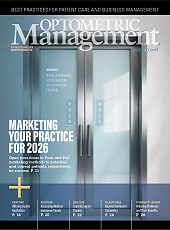In a randomized clinical trial published in JAMA Ophthalmology, researchers reported that diversified segmental defocus optimization (DSDO) spectacle lenses significantly reduced the incidence and progression of myopia in children without myopia. However, they found no additional benefit when combining DSDO lenses with low-dose atropine.
The double-masked, placebo-controlled study was conducted at Peking University People’s Hospital’s Department of Ophthalmology. A total of 450 children aged 5 to 12 years with baseline spherical equivalent refraction (SER) between 0.00 D and 1.00 D were randomly assigned to one of three groups:
- DSDO lenses + placebo eye drops (DSDO group)
- DSDO lenses + 0.01% atropine (DSDOA group)
- Single-vision lenses + placebo eye drops (control group)
The intervention lasted 1 year and 370 children completed the follow-up.
Primary Outcomes
At the end of 12 months, the cumulative myopia incidence was 5.8% in the DSDO group, 4.8% in the DSDOA group, and 15.3% in the control group. Fast myopic shift of at least 0.50 D was observed in 15.7% of the DSDO group, 9.6% of the DSDOA group, and 42.7% of the control group.
Statistical analysis showed significantly lower myopia incidence in the DSDO (difference: 9.5%; P=.02) and DSDOA (difference: 10.5%; P=.006) groups compared to control. The difference between DSDO and DSDOA groups was not statistically significant (P=.73).
Secondary Outcomes
At one year, mean SER change was −0.11 D in the DSDO group, −0.01 D in the DSDOA group, and −0.30 D in the control group (P<.001). Mean axial length increase was 0.16 mm (DSDO), 0.14 mm (DSDOA), and 0.27 mm (control) (P<.001).
“Patients with fast myopic shift in the control group showed greater reductions in subfoveal choroidal thickness, luminal area, and total choroidal area compared with those without fast myopic shift,” the authors wrote. “DSDO lenses markedly attenuated choroidal thinning, particularly in the 3- to 6-mm zone, with most pronounced effects within the first 3 months. This choroidal preservation may underlie its myopic control efficacy.”
Lens Design and Intervention Protocol
The DSDO lenses included a central 9.5-mm optical zone surrounded by 256 peripheral microlenses that were arranged in 8 concentric rings. The plus power transitioned from +4.0 D to +3.0 D across the rings to target peripheral retinal defocus. Children were instructed to wear lenses for at least 8 hours per day, 5 days per week, and apply eye drops nightly.
Safety and Tolerability
Mild adverse events were reported in 10.4% of participants. The most common effect was asthenopia, which was attributed to academic workload and screen time. No serious safety concerns were identified.
The trial supports the use of DSDO spectacle lenses as an effective and noninvasive method for delaying the onset of myopia in children. The addition of 0.01% atropine did not enhance the lenses’ efficacy, though the authors noted that the “findings highlight DSDO’s exceptional efficacy rather than disproving atropine’s value in other contexts.” They concluded that further research with longer follow-up is recommended to validate these findings.



